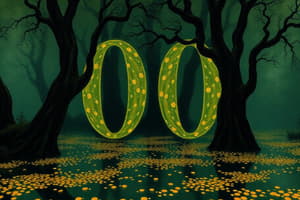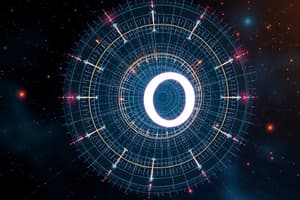Podcast
Questions and Answers
What is something found in nature that humans can use?
What is something found in nature that humans can use?
- An artificial creation
- A natural resource (correct)
- A manufactured product
- A synthetic material
Where do the vegetables you eat come from?
Where do the vegetables you eat come from?
- Created in factories
- Made from oil
- Growing plants (correct)
- Mined from underground
What raw material is glass made from?
What raw material is glass made from?
- Metal
- Oil
- Sand (correct)
- Plastic
How can natural resources be classified?
How can natural resources be classified?
Which type of resource has a limited supply?
Which type of resource has a limited supply?
How long does it take for nonrenewable resources to form?
How long does it take for nonrenewable resources to form?
Which of the following is an example of a nonrenewable resource?
Which of the following is an example of a nonrenewable resource?
What makes a resource renewable?
What makes a resource renewable?
Which of the following is a renewable resource because plants constantly produce oxygen?
Which of the following is a renewable resource because plants constantly produce oxygen?
What do resources need to be to remain renewable?
What do resources need to be to remain renewable?
What do we use land for?
What do we use land for?
What would happen without soil?
What would happen without soil?
How long can it take for soil to form?
How long can it take for soil to form?
What do forests provide?
What do forests provide?
What role do forests play in controlling the amount of carbon dioxide?
What role do forests play in controlling the amount of carbon dioxide?
Wetlands are examples of what?
Wetlands are examples of what?
About how many acres of forest land does California have?
About how many acres of forest land does California have?
Flashcards
Natural resource
Natural resource
Materials from nature used by humans.
Classify
Classify
To sort into groups.
Nonrenewable resource
Nonrenewable resource
A resource that cannot be replaced quickly.
Renewable resource
Renewable resource
Signup and view all the flashcards
Land
Land
Signup and view all the flashcards
Forest
Forest
Signup and view all the flashcards
Study Notes
Algorithmic Complexity: What?
- It is an approximate measure of the time and/or space an algorithm needs
- The measure is dependent on the size of the input
- It is expressed using "Big O" notation as: O(f(n))
- Where n is the input size
- f(n) is a function that grows as n grows
Algorithmic Complexity: Why?
- To compare different algorithms
- To predict algorithm performance
- To avoid the use of slow algorithms
Algorithmic Complexity: How?
- First choose a metric, either time or space
- Then determine the input size: n
- Calculate the amount by which the metric changes as "n" increases
- This may require an inspection of code
- Ignore any constants
- Express as O(f(n))
Common complexities
- Constant: O(1), example is accessing an array element
- Logarithmic: O(log(n)), example is binary search
- Linear: O(n), example is searching an unsorted array
- Linearithmic: O(nlog(n)), example is merge sort
- Quadratic: O(n^2), example is bubble sort
- Exponential: O(2^n), example is calculating Fibonacci recursively
Visualized Complexities
- Constant: Horizontal line at y=1, indicating constant growth
- Logarithmic: Curve that grows very slowly, starting near the origin and increasing gradually
- Linear: Straight line that grows proportionally with the input size
- Linearithmic: Curve that grows faster than linear but slower than quadratic
- Quadratic: Curve that grows rapidly as the input size increases
- Exponential: Curve that grows extremely rapidly as the input size increases
Studying That Suits You
Use AI to generate personalized quizzes and flashcards to suit your learning preferences.




